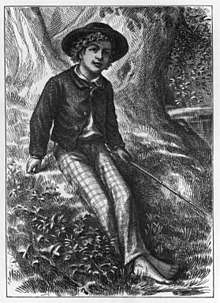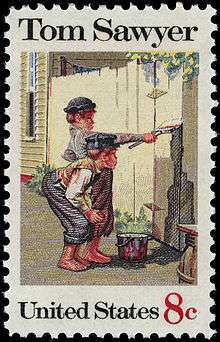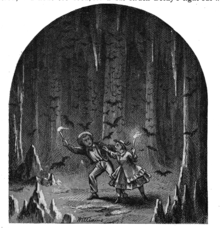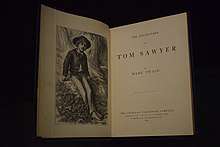The Adventures of Tom Sawyer
 Front piece of The Adventures of Tom Sawyer, 1876 1st edition. | |
| Author | Mark Twain |
|---|---|
| Country | United States |
| Language | English, Limited Edition (Spanish) |
| Genre | Bildungsroman, picaresque novel, satire, folk, children's literature |
| Publisher | American Publishing Company |
Publication date | 1876[1] |
| OCLC | 47052486 |
| 813.4 | |
| LC Class | PZ7.T88 Ad 2001 |
| Followed by | Adventures of Huckleberry Finn |
| Text | The Adventures of Tom Sawyer [V-2] at Wikisource |
The Adventures of Tom Sawyer by Mark Twain is an 1876 novel about a young boy growing up along the Mississippi River. It is set in the 1840s in the fictional town of St. Petersburg, inspired by Hannibal, Missouri, where Twain lived as a boy.[2] In the novel Tom Sawyer has several adventures, often with his friend, Huck. One such adventure, Tom's whitewashing of a fence, has been adapted into paintings and referenced in other pieces of popular culture. Originally a commercial failure[3] the book ended up being the best selling of any of Twain's works during his lifetime.[4]
Plot


Tom Sawyer lives with his Aunt Polly and his half-brother Sid. He skips school to swim and is made to whitewash the fence the next day as punishment. He cleverly persuades his friends to trade him small treasures for the privilege of doing his work.
Tom falls in love with Becky Thatcher, a new girl in town, and persuades her to get "engaged" by kissing him. But their romance collapses when she learns Tom has been "engaged" previously to Amy Lawrence. Becky cried for a great deal of time until the other students began to notice, and she became embarrassed. Shortly after Becky shuns him, he accompanies Huckleberry Finn to the graveyard at night, where they witness a trio of body snatchers, Dr. Robinson, Muff Potter, and Injun Joe, getting into a fight in which Robinson is murdered by Injun Joe. Tom and Huckleberry Finn swear a blood oath to not tell anyone about the murder, as they feel that if they do, Injun Joe would murder them.
Bored by school, Tom, his best friend Joe Harper, and Huck run away to an island in the Mississippi called Jackson's Island. While enjoying their new-found freedom, they become aware that the community is sounding the river for their bodies. Tom sneaks back home one night to observe the commotion. After a brief moment of remorse at his loved ones' suffering, he is struck by the idea of appearing at his own funeral. The trio later carries out this scheme by making a sensational sudden appearance in the church in the middle of their joint funeral service.
Back in school, Tom gets himself back in Becky's favour after he nobly accepts the blame and punishment for a book she has ripped.
In court, Injun Joe pins the murder on Muff Potter, but Tom and Huckleberry Finn know he is innocent. At Potter's trial, Tom decides to speak out and Joe escapes through a window before he can be apprehended. Henceforth the boys live in constant fear of Joe's revenge on them for incriminating him.
Summer arrives, and Tom and Huck go hunting for buried treasure in a haunted house. After venturing upstairs they hear a noise below. Peering through holes in the floor, they see Injun Joe disguised as a deaf-mute Spaniard; Injun Joe and his companion plan to bury some stolen treasure of their own. From their hiding spot, Tom and Huck wriggle with delight at the prospect of digging it up. By chance the villains discover an even greater gold hoard buried in the hearth and carry it all off to a better secret hiding place. The boys are determined to find where it has gone. One night Huck spots them and follows them. He overhears their plans to attack the wealthy Widow Douglas. By running to fetch help, Huck prevents the crime and becomes an anonymous hero.
In the meantime, Tom goes on a picnic to McDougal's Cave with Becky and their classmates. Tom and Becky get separated from the others and wander lost in the extensive cave complex for the next few days. Becky gets extremely dehydrated and starved, so Tom's search for a way out gets even more desperate. He accidentally encounters Injun Joe in the caves one day but is not seen by his nemesis. Eventually, he finds a way out, and they are joyfully welcomed back by their community. As a preventive measure, Judge Thatcher, Becky's father, has McDougal's Cave sealed off with an iron door, but this traps Injun Joe inside. When Tom hears of the sealing several days later and directs a posse to the cave, they find Injun Joe's corpse just inside the sealed entrance, starved to death.
A week later, having deduced from Injun Joe's presence at McDougal's Cave that the villain must have hidden the stolen gold inside, Tom takes Huck to the cave and they find the box of gold, the proceeds of which are invested for them. The Widow Douglas adopts Huck, but he finds the restrictions of a civilized home life painful. He attempts to escape back to his vagrant life. Tom tricks him into thinking that he can later join Tom's new scheme of starting a robber band if he returns to the widow. Reluctantly, Huck agrees and goes back to her.
See also List of Tom Sawyer characters.
Significance
The novel has elements of humour, satire and social criticism; features that later made Mark Twain one of the most important authors of American literature. Mark Twain describes some autobiographical events in the book. The novel is set around Twain's actual boyhood home of Hannibal, near St. Louis, and many of the places in it are real and today support a tourist industry as a result.[5]
Inception
Tom Sawyer is Twain's first attempt to write a novel on his own. He had previously written contemporary autobiographical narratives (The Innocents Abroad or The New Pilgrims' Progress, Roughing It) and two short texts called sketches which parody the youth literature of the time. These are The Story of the Good Boy and The Story of the Wicked Little Boy which are satirical texts of a few pages. In the first, a model child is never rewarded and ends up dying before he can declaim his last words which he has carefully prepared. In the second story, an evil little boy steals and lies, like Tom Sawyer, but finishes rich and successful. Tom appears as a mixture of these little boys since he is at the same time a scamp and a boy endowed with a certain generosity.
By the time he wrote Tom Sawyer, Twain was already a successful author based on the popularity of The Innocents Abroad. He owned a large house in Hartford, Connecticut but needed another success to support himself, with a wife and two daughters. He had collaborated on a novel with Charles Dudley Warner, The Gilded Age published in 1874.[6]
He had earlier written an unpublished memoir of his own life on the Mississippi and corresponded with a boyhood friend, Will Bowen, that had evoked many memories and was used as a source of material.
Twain named his fictional character after a San Francisco fireman whom he met in June 1863. The real Tom Sawyer was a local hero, famous for rescuing 90 passengers after a shipwreck. The two remained friendly during Twain's three-year stay in San Francisco, often drinking and gambling together.[7]
Publication

In November 1875 Twain gave the manuscript to Elisha Bliss of the American Publishing Company, who sent it to True Williams for the illustrations. A little later, Twain had the text also quickly published at Chatto and Windus of London, in June 1876, but without illustration. Pirate editions appeared very quickly in Canada and Germany. The American Publishing Company finally published its edition in December 1876, which was the first illustrated edition of Tom Sawyer.[8]
These two editions differ slightly. After completing his manuscript, Twain had a copy made of it. It is this copy which was read and annotated by his friend William Dean Howells. Twain then made his own corrections based on Howells comments which he later incorporated in the original manuscript, but some corrections escaped him. The English edition was based on this corrected copy, while the illustrated American edition was based on the original manuscript. To further complicate matters, Twain was personally concerned with the revision of the proofs of the American edition, which he did not do for the English edition. The American edition is therefore considered the authoritative edition.
Critical analysis
A third person narrator describes the experiences of the boys, interspersed with occasional social commentary. In its sequel, Huckleberry Finn, Mark Twain changes to a first person narrative which takes moral conflicts more personally and thus makes greater social criticism possible.[9]
Sometimes the book is described as racist because black people are called "niggers" in the text. A cleansed version, which no longer contained the word, aroused indignation among some literary critics.[10]
Sequels and other works featuring Tom Sawyer
- Adventures of Huckleberry Finn (1884)
- Tom Sawyer Abroad (1894)
- Tom Sawyer, Detective (1896)
Tom Sawyer, the story's title character, also appears in two other uncompleted sequels: Huck and Tom Among the Indians and Tom Sawyer's Conspiracy. He is also a character in Twain's unfinished Schoolhouse Hill.
Adaptations and influences
Film and television
- Tom Sawyer (1917), directed by William Desmond Taylor, starring Jack Pickford as Tom[11]
- Tom Sawyer (1930), directed by John Cromwell, starring Jackie Coogan as Tom[12]
- Tom Sawyer (1936), Soviet Union version directed by Lazar Frenkel and Gleb Zatvornitsky[13]
- The Adventures of Tom Sawyer (1938), Technicolor film by the Selznick Studio, starring Tommy Kelly as Tom and directed by Norman Taurog; most notable is the cave sequence designed by William Cameron Menzies[14]
- The Adventures of Tom Sawyer (1960), BBC television series in 7 episodes starring Fred Smith as Tom and Janina Faye as Becky. The series' theme song was "John Gilbert is the Boat", sung by Peggy Seeger[15]
- Les aventures de Tom Sawyer (1968), Romanian/French/German television miniseries directed by Wolfgang Liebeneiner, starring Roland Demongeot as Tom and Marc Di Napoli as Huck[16]
- Aventurile lui Tom Sawyer (1968), Romanian movie directed by Mircea Albulescu.
- The New Adventures of Huckleberry Finn (1968), a half-hour live-action/animated series produced by Hanna-Barbera Productions[17]
- Las Aventuras de Juliancito (1969), Mexican film[18]
- Tom Sawyer (1973), musical adaptation by Robert B. Sherman and Richard M. Sherman, with Johnny Whitaker in the title role, Jeff East as Huck Finn, Jodie Foster as Becky Thatcher, and Celeste Holm as Aunt Polly.[19]
- Tom Sawyer (1973), TV movie version sponsored by Dr Pepper, starring Buddy Ebsen as Muff Potter and filmed in Upper Canada Village[20]
- Páni kluci (1976), Czech movie directed by Věra Plívová-Šimková
- Huckleberry Finn and His Friends (1979), TV series[21]
- The Adventures of Tom Sawyer (1980), Japanese anime television series by Nippon Animation, part of the World Masterpiece Theater, aired in the United States on HBO
- The Adventures of Tom Sawyer and Huckleberry Finn (Приключения Тома Сойера и Гекльберри Финна), 1981 Soviet Union version directed by Stanislav Govorukhin[22]
- Tom Sawyer (1984), Canadian claymation version produced by Hal Roach studios
- Tom and Huck (1995), starring Jonathan Taylor Thomas as Tom and Brad Renfro as Huck Finn[23]. The story takes place in contemporary time.
- Tom Sawyer (2000), animated adaptation featuring the characters as anthropomorphic animals instead of humans with an all-star voice cast, including country singers Rhett Akins, Mark Wills, Lee Ann Womack, Waylon Jennings, and Hank Williams Jr. as well as Betty White[24]
- Thomas Sawyer, as a young adult, is a character in the movie League of Extraordinary Gentlemen, portrayed by Shane West. Here, Tom is a U.S. Secret Service agent who joins the team's fight against Professor Moriarty.
- Tom Sawyer & Huckleberry Finn (2014), starring Joel Courtney as Tom and Jake T. Austin as Huck.
- Band of Robbers, a 2015 American crime comedy film written and directed by the Nee Brothers[25]
Theatrical
- In 1956, We're From Missouri, a musical adaptation of The Adventures of Tom Sawyer, with book, music, and lyrics by Tom Boyd, was presented by the students at the Guildhall School of Music and Drama.
- In 1960, Tom Boyd's musical version (re-titled Tom Sawyer) was presented professionally at Theatre Royal Stratford East in London, England, and in 1961 toured provincial theatres in England.[26][27]
- In 1981, the play "The Boys in Autumn" was premiered in San Francisco by the American dramatist Bernhard Sabath, in which Tom Sawyer and Huck Finn meet again as old men. Despite good reviews, the play has remained largely unknown.[28]
- In 2001, the musical The Adventures of Tom Sawyer, by Ken Ludwig and Don Schlitz, debuted on Broadway.[29]
- In 2015, the Mark Twain House and Museum selected 17-year-old Noah Altshuler (writer of Making the Move), as Mark Twain Playwright in Residence, to create a modern, meta-fictional adaptation of The Adventures of Tom Sawyer for regional and commercial production.[30]
Ballet
Tom Sawyer: A Ballet in Three Acts premiered on October 14, 2011, at the Kauffman Center for the Performing Arts in Kansas City, Missouri. The score was by composer Maury Yeston, with choreography by William Whitener, artistic director of the Kansas City Ballet.[31][32] A review in The New York Times observed: "It’s quite likely that this is the first all-new, entirely American three-act ballet: it is based on an American literary classic, has an original score by an American composer and was given its premiere by an American choreographer and company. ... Both the score and the choreography are energetic, robust, warm, deliberately naïve (both ornery and innocent), in ways right for Twain."[33]
Video games
- The Adventures of Tom Sawyer, an action-platformer for the Nintendo Entertainment System. It was released by SeTa in February 1989 in Japan and August that same year in North America.
- Square's Tom Sawyer, a role-playing video game produced by Square. It was released in March 1989 for Japan on the Famicom.
Internet
On November 30, 2011, to celebrate Twain’s 176th birthday, the Google Doodle was a scene from The Adventures of Tom Sawyer.[34]
Song
Canadian rock band Rush published a song entitled Tom Sawyer in 1981, which is inspired by the book.[35]
See also
References
- ↑ Facsimile of the original 1st edition.
- ↑ "American Literature: Mark Twain". www.americanliterature.com. Retrieved 29 January 2015.
- ↑ Railton, Stephen. "The Adventures of Tom Sawyer". Mark Twain in His Times. University of Virginia. Retrieved 2 April 2018.
- ↑ Messent, Peter (2007). The Cambridge Introduction to Mark Twain. Cambridge, England: Cambridge University Press. Retrieved 2 April 2018.
- ↑ Norkunas, Martha K. (1993). The Politics of Public Memory: Tourism, History, and Ethnicity in Monterey, California. SUNY Press. p. 60. ISBN 0791414841.
- ↑ Gailey, Amanda. "The Gilded Age : A Tale of Today". Encyclopedia of American Literature.
- ↑ Graysmith, Robert (October 2012). "The Adventures of the Real Tom Sawyer". Smithsonian Magazine. Retrieved November 15, 2012.
- ↑ Twain, Mark (1967). Hill, Hamlin Lewis, ed. Mark Twain's Letters to his Publishers 1867-1894. Berkeley, California: University of California Press.
- ↑ Groß-Langenhoff, Barbara (2006). Social Criticism in The Adventures of Tom Sawyer and Huckleberry Finn. GRIN Verlag,. ISBN 363845682X.
- ↑ "Opinion | That's Not Twain". The New York Times. 2011. ISSN 0362-4331. Retrieved 2017-09-18.
- ↑ "Tom Sawyer". Archived from the original on 2012-02-07.
- ↑ "Tom Sawyer (1930)". IMDB. Retrieved November 14, 2012.
- ↑ "Tom Sawyer (1936)". IMDB. Retrieved November 14, 2012.
- ↑ "THE ADVENTURES OF TOM SAWYER (1938)". tcm.com. Retrieved November 14, 2012.
- ↑ "The Adventures of Tom Sawyer (1960– )". IMDB. Retrieved November 14, 2012.
- ↑ "Les aventur Sawyer (1968– )". IMDB. Retrieved November 14, 2012.
- ↑ "The New Adventures of Huckleberry Finn (1968–1969)". IMDB. Retrieved November 14, 2012.
- ↑ "Aventuras de Juliancito (1969)". IMDB. Retrieved November 14, 2012.
- ↑ "Tom Sawyer (1973)". IMDB. Retrieved November 14, 2012.
- ↑ "Tom Sawyer (TV 1973)". IMDB. Retrieved November 14, 2012.
- ↑ "Huckleberry Finn and His Friends (1979– )". IMDB. Retrieved November 14, 2012.
- ↑ "The Adventures of Tom Sawyer and Huckleberry Finn (1981)". nytimes.com. Retrieved November 14, 2012.
- ↑ "Tom and Huck (1995)". IMDB. Retrieved November 14, 2012.
- ↑ "Tom Sawyer (Video 2000)". IMDB. Retrieved November 14, 2012.
- ↑ "Tom Sawyer & Huckleberry Finn (2014)". IMDB. Retrieved February 27, 2015.
- ↑ "TOM SAWYER - London production". www.tomboyd.net. Retrieved 2016-08-13.
- ↑ Frankos, Laura (2010-01-01). The Broadway Musical Quiz Book. Hal Leonard Corporation. p. 267. ISBN 9781423492757.
- ↑ Rich, Frank (1986-05-01). "THEATER: 'THE BOYS IN AUTUMN'". The New York Times. ISSN 0362-4331. Retrieved 2017-10-02.
- ↑ Weber, Bruce (2001-04-27). "THEATER REVIEW; An Older (and Calmer) Tom Sawyer". The New York Times. ISSN 0362-4331. Retrieved 2017-10-02.
- ↑ Giola, Michael (March 24, 2015). "Could a 17-Year-Old Bring Mark Twain's "The Adventures of Tom Sawyer" Back to Broadway?". Playbill.
- ↑ Horsley, Paul. "An American Ballet: KCB Presents World Premiere Of Ambitious New Piece" Archived 2013-01-27 at Archive.is, KCIndependent.com, accessed June 23, 2012
- ↑ Jones, Kenneth. "Maury Yeston's Tom Sawyer Ballet Will Get World Premiere in 2011" Archived 2010-11-12 at the Wayback Machine., Playbill.com, November 9, 2012
- ↑ Macaulay, Alastair. "Yes, Those Are Tom, Becky and Huck Leaping", NYTimes.com, October 24, 2011,
- ↑ "Mark Twain's 176th Birthday", google.com, November 30, 2011
- ↑ "Tom Sawyer by Rush Songfacts". www.songfacts.com. Retrieved 2017-10-02.
External links
| Wikisource has original text related to this article: |
- The Adventures of Tom Sawyer at Project Gutenberg
- The Adventures of Tom Sawyer, 135th Anniversary Edition, University of California Press, 2010.
- The Adventures of Tom Sawyer. The digitized copy of the first American edition from Internet Archive (1876).

- Twain, Mark, 1835-1910. The Adventures of Tom Sawyer - Free eBook in HTML format at the Electronic Text Center, University of Virginia Library.
- First edition illustrations by True Williams